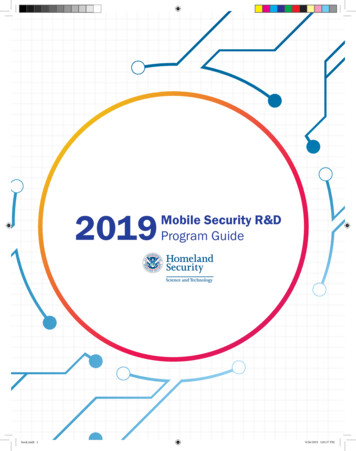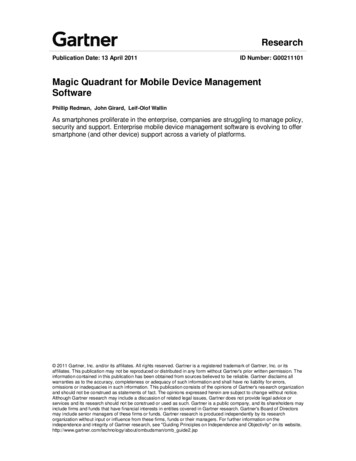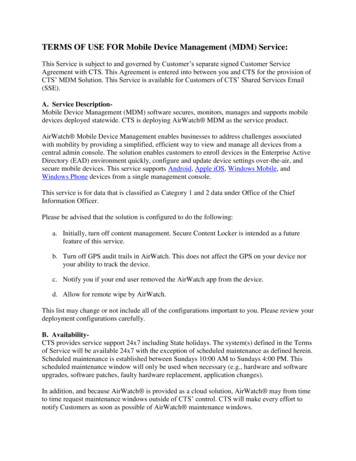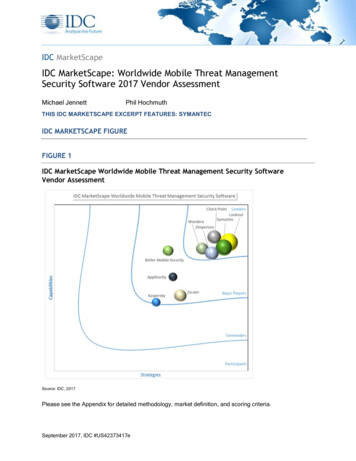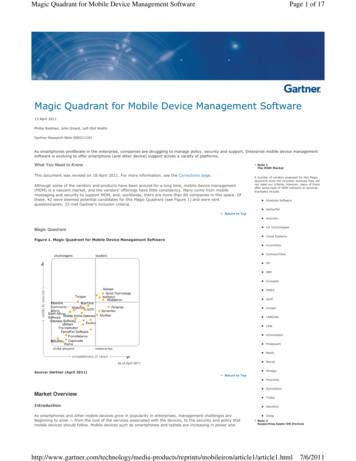
Transcription
Spring 2018CS 155Mobile Device and PlatformSecurity – Part IIJohn Mitchell
Two lectures on mobile security› Introduction: platforms and trends› Threat categories§ Physical, platform malware, malicious apps› Defense against physical theft› Malware threats› System architecture and defenses§ Apple iOS security features and app security model§ Android security features and app security model› Security app development§ WebView – secure app and web interface dev§ Device fragmentationThursTues
ANDROIDHistory and early decisions
Android history› Android, Inc founded by Andy Rubin around 2005§ Worked with HTC-built device with a physical keyboard§ Scrapped Blackberry-like phone when iPhone came out§ First Android phone HTC Dream, Oct 2008 (T-Mobile G1):touchscreen and keyboard› Open-source software project› Backed and acquired by Google
HTC Dream› First phone had§ Android 1.6 (Donut)§ 3.15 megapixel rearcamera with auto-focus§ 3.2 inch touchscreen§ Gmail, Google Maps,Search, Google Talk, YouTube, calendar, contacts,alarm
Android ecosystem› Open-source software distributed by Google§ Business goal: increase number of users and devices linked tocore Google products› Multiple hardware vendors§ Each customize software for their products› Open marketplace for apps§ Aim for scaleAside: open-source OS successful pre-mobile
App market› Self-signed apps› App permissions§ granted on userinstallation› Open market§ Bad apps may show up on market§ Shifts focus from remote exploit to privilege escalation
ANDROID PLATFORMTheft and loss protection
Predictive security§ Look for malicious code in appsPrivacy advisor§ See if app can access private informationLocate lost phone§ Map location and make a soundLock and wipe§ Web interface to remotely remove data§ Data backup§ Store and retrieve from cloudhttps://www.lookout.com/android
Device lock and unlock› Similar PIN and fingerprint› Fingerprint API lets users§ Unlock device§ Securely sign in to apps§ Use Android Pay§ Purchase on Play Store
ANDROID PLATFORMManaged code
Managed code overview› Java programming language› Bytecode execution environment§ Verifier§ Run-time checks§ Memory safety› Permission checking§ Stack inspection
Java language overviewClasses and Inheritance§ Object features§ Encapsulation§ InheritanceTypes and Subtyping§ Primitive and ref types§ Interfaces; arrays§ Exception hierarchyGenerics§ Subtype polymorphism.generic programmingVirtual machine§ Loader and initialization§ Linker and verifier§ Bytecode interpreterSecurity§ Java “sandbox”§ Type safety§ Stack inspection
Managed code overviewJava programming languageBytecode execution environment§ Verifier§ Run-time checks§ Memory safetyPermission checking§ Stack inspection
Java Implementation› Compiler and Virtual Machine§ Compiler produces bytecode§ Virtual machine loads classes on demand, verifies bytecodeproperties, interprets bytecode› Why this design?§ Bytecode interpreter “manages” code execution safely§ Minimize machine-dependent part of implementation
Java Virtual Machine ArchitectureA.javaJavaCompilerA.classCompile source codeJava Virtual MachineLoaderVerifierLinkerBytecode Interpreter
JVM Linker and Verifier› Linker§ Adds compiled class or interface to runtime system§ Creates static fields and initializes them§ Resolves names› Checks symbolic names and replaces with direct references› Verifier§ Check bytecode of a class or interface before loaded§ Throw exception if error occurs
Verifier› Bytecode may not come from standard compiler§ Evil hacker may write dangerous bytecode› Verifier checks correctness of bytecode§ Every instruction must have a valid operation code§ Every branch instruction must branch to the start of some otherinstruction, not middle of instruction§ Every method must have a structurally correct signature§ Every instruction obeys the Java type discipline› Last condition is fairly complicated.
Bytecode interpreter / JIT› Standard Java virtual machine interprets instructions§ Perform run-time checks such as array bounds§ Possible to compile bytecode class file to native code› Java programs can call native methods§ Typically functions written in C› Just-in-time compiler (JIT)§Translate set of bytecodes into native code, including checks› Ahead-of-time (AOT)§Similar principles but prior to loading into runtime system
Type Safety of Java› Run-time type checking§ All casts are checked to make sure type safe§ All array references are checked to make sure the array index iswithin the array bounds§ References are tested to make sure they are not null before theyare dereferenced.› Additional features§ Automatic garbage collection§ No pointer arithmeticIf program accesses memory, that memory is allocatedto the program and declared with correct type
Managed code overviewJava programming languageBytecode execution environment§ Verifier§ Run-time checks§ Memory safetyPermission checking§ Stack inspection
Managed code overview› Java programming language› Bytecode execution environment§ Verifier§ Run-time checks§ Memory safety› Permission checking§ Stack inspection
ANDROID PLATFORMPlatform security model
Android platform modelArchitecture components§ Operating system, runtime environment§ Application sandbox§ Exploit preventionPermission system§ Granted at install time§ Checked at run timeInter-app communication§ Intent system§ Permission redelegation (intent input checking)
Android platform summary§ Linux kernel, browser, SQL-lite database§ Software for secure network communication› Open SSL, Bouncy Castle crypto API and Java library§ C language infrastructure§ Java platform for running applications› Dalvik bytecode, virtual machine / Android runtime (ART)
Managed code runs in app sandboxApplication development process: source code to bytecode
Security Features› Isolation§ Multi-user Linux operating system§ Each application normally runs as a different user› Communication between applications§ May share same Linux user ID› Access files from each other› May share same Linux process and Dalvik VM§ Communicate through application framework› “Intents,” based on Binder, discussed in a few slides
Application sandbox›Application sandbox§ Each application runs with its UID in its own runtime environment› Provides CPU protection, memory protection› Only ping, zygote (spawn another process) run as root››Applications announce permission requirement§ Create a whitelist model – user grants access at install timeCommunication between applications§ May share same Linux user ID› Access files from each other› May share same Linux process and runtime environment§ Or communicate through application framework› “Intents,” reference monitor checks permissions
App
Android platform modelArchitecture components§ Operating system, runtime environment§ Application sandbox§ Exploit preventionPermission system§ Granted at install time§ Checked at run timeInter-app communication§ Intent system§ Permission redelegation (intent input checking)
Exploit prevention›››Open source: public review, no obscurityGoals§ Prevent remote attacks, privilege escalation§ Secure drivers, media codecs, new and custom featuresOverflow prevention§ ProPolice stack protection› First on the ARM architecture§ Some heap overflow protections›› Chunk consolidation in DL malloc (from OpenBSD)ASLR§ Avoided in initial release› Many pre-linked images for performance§ Later developed and contributed by Bojinov, Boneh
dlmalloc (Doug Lea)› Stores meta data in band› Heap consolidation attack§ Heap overflow can overwrite pointers to previous and nextunconsolidated chunks§ Overwriting these pointers allows remote code execution› Change to improve security§ Check integrity of forward and backward pointers› Simply check that back-forward-back back, f-b-f f§ Increases the difficulty of heap overflow
Android platform modelArchitecture components§ Operating system, runtime environment§ Application sandbox§ Exploit preventionPermission system§ Granted at install time§ Checked at run timeInter-app communication§ Intent system§ Permission redelegation (intent input checking)
Android market› Self-signed apps› App permissions granted on user installation› Open market§ Bad applications may show up on market§ Shifts focus from remote exploit to privilege escalation
Android permissions› Example of permissions provided by �android.permission.READ EXTERNAL STORAGE“android.permission.SEND SMS”“android.permission.BLUETOOTH”› Also possible to define custom permissions
Android permission modelhttps://www.owasp.org/images/3/3e/Danelon OWASP EU Tour 2013.pdf
Android permission modelhttps://www.owasp.org/images/3/3e/Danelon OWASP EU Tour 2013.pdf
Android platform modelArchitecture components§ Operating system, runtime environment§ Application sandbox§ Exploit preventionPermission system§ Granted at install time§ Checked at run timeInter-app communication§ Intent system§ Permission redelegation (intent input checking)
Application development concepts› Activity – one-user task§ Example: scroll through your inbox§ Email client comprises many activities› Intents – asynchronous messaging system§ Fire an intent to switch from one activity to another§ Example: email app has inbox, compose activity, viewer activity› User click on inbox entry fires an intent to the viewer activity, which thenallows user to view that email
Android Intents› Intent is a bundle of information, e.g.,§ action to be taken§ data to act on§ category of component to handle the intent§ instructions on how to launch a target activity› Routing can be§ Explicit: delivered only to a specific receiver§ Implicit: all components that have registered to receive thataction will get the message
Layers of security§ Each application executes as its own user identity§ Android middleware has reference monitor that mediates theestablishment of inter-component communication (ICC)Source: Penn State group Android security paper
Source: Penn State group, Android security tutorial
Security issues with intents› Sender of an intent may§ Verify that the recipient has a permission by specifying apermission with the method call§ Use explicit intents to send the message to a single component› Receivers must implement appropriate input checking to handlemalicious intents
Attack: Permission redelegation› Idea: an application without a permission gains additionalprivileges through another application› Example of the “confused deputy” problem
Permission lon OWASP EU Tour 2013.pdf
Permission lon OWASP EU Tour 2013.pdf
How could this happen?› App w/ permissions exposes a public interface› Study in 2011§ Examine 872 apps§ 320 of these (37%) have permissions and at least one type of publiccomponent§ Construct attacks using 15 vulnerabilities in 5 apps› Reference§ Permission Re-Delegation: Attacks and Defenses, Adrienne Felt, HelenWang, Alexander Moshchuk, Steven Hanna, Erika Chin, Usenix 2011
Example: power control widget› Default widgets provided by Android, present on all devices› Can change Wi-fi, BT, GPS, Data Sync, Screen Brightness withonly one click› Uses Intent to communicate the event of switching settings› A malicious app without permissions can send a fake Intent tothe Power Control Widget, simulating click to switch settingshttps://www.owasp.org/images/3/3e/Danelon OWASP EU Tour 2013.pdf
Vulnerable versions (in red)Principle of least privilege helps but is not solution by itselfApps with permissions need to manage securityhttps://www.owasp.org/images/3/3e/Danelon OWASP EU Tour 2013.pdf
Android platform modelArchitecture components§ Operating system, runtime environment§ Application sandbox§ Exploit preventionPermission system§ Granted at install time§ Checked at run timeInter-app communication§ Intent system§ Permission redelegation (intent input checking)
ANDROID PLATFORMMobile web apps
Outline› Mobile web apps§ Use WebView Java objects, implemented based on WebKit browser§ “JavaScript bridge” lets web content use Java objects exported by app› Security problems§ WebView does not isolate bridge access by frame or origin§ App environment may leak sensitive web information in URLs§ WebView does not provide security indicators§
Mobile Web AppsMobile web app: embeds a fully functional web browser as aUI element
JavaScript BridgeObj foo new Object();addJavascriptInterface(foo, ‘f’);JavaJavaScript
JavaScript Bridgef.bar();JavaJavaScript
Security ConcernsWho can access the bridge?§ EveryoneIsolated in Browser
No origin distinction in WebView callsf.bar();JavaJavaScript
Analysis of Public Apps› How many mobile web apps?› How many use JavaScript Bridge?› How many vulnerable?
Experimental Results››››737,828 free apps from Google Play (Oct ’13)563,109 apps embed a browser219,404 use the JavaScript Bridge107,974 have at least one security violation
Most significant vulnerabilities1. Loading untrusted web content2. Leaking URLs to foreign apps3. Exposing state changing navigation to foreign apps
Loading untrusted web content“You should restrict the web-pages thatcan load inside your WebView with awhitelist.”- Facebook“ only loading content from trustedsources into WebView will help protectusers.”- Adrian Ludwig, Google
Forms of navigation// In app codemyWebView.loadUrl(“foo.com”); !-- In HTML -- a href “foo.com” click! /a !-- More HTML -- iframe src “foo.com”/ // In JavaScriptwindow.location “foo.com”;
Implementing navigation whitelistpublic boolean shouldOverrideUrlLoading(WebView view, String url){// False - Load URL in WebView// True - Prevent the URL load}
public boolean shouldOverrideUrlLoading(WebView view, String url){String host new ��))return false;log(“Overrode URL: ” url);return true;}
Reach Untrusted Content?› 40,084 apps with full URLs and use JavaScript Bridge› 13,683 apps (34%) can reach untrusted content
Exposing sensitive information in URLs› Android apps communicate using intents§ An implicit intent is delivered to any app whose filter matches§ An intent filter can declare zero or more data elements, such as› mimeType - e.g., android:mimeType "video/mpeg“› scheme - e.g., android:scheme "http"› When a WebView loads a page, an intent is sent to the app§ Another app can register a filter that might match this intent§ If the URL contains sensitive information, this information can bestolen
ExampleOAuth protocol for browser-based web authentication§ Used by Google, Facebook, LinkedIn and other identity providers§ In some configurations, may return a session token as part of a URLMobile app developers may try to use OAuth through WebView§ A form of session token is returned as part of a URL§ Delivered through an implicit intent§ May reach any app with filter that specifies protocol scheme my oauthMalicious app may steal a session token from a vulnerable app§ Malicious app registers an implicit intent with scheme my oauth§ Waits for a URL containing the form of session token returned by OAuth.
Handling SSL ErrorsonReceivedSslError1. handler.proceed()2. handler.cancel()3. view.loadUrl(.)
Mishandling SSL Errors117,974 apps implement onReceivedSslError29,652 apps (25%) must ignore errors
Primary resultsVulnerability% Relevant % VulnerableUnsafe Nav1534HTTP4056Unsafe HTTPS2729
Popularity
Outdated Apps
Libraries29%unsafe nav51%HTTP53%unsafe HTTPS
Additional security issuesBased on 998,286 free web apps from June 2014
Summary› Mobile web apps§ Use WebView Java objects, implemented based on WebKit browser§ “JavaScript bridge” lets web content use Java objects exported by app› Security problems§ WebView does not isolate bridge access by frame or origin§ App environment may leak sensitive web information in URLs§ WebView does not provide security indicators§ § Many browser security mechanism are not automatically provided byWebView
ANDROID PLATFORMTarget fragmentation
Summary› Android apps can run using outdated OS behavior- The large majority of Android apps do this- Including popular and well maintained apps› Outdated security code invisibly permeates the app ecosystem- “Patched” security vulnerabilities still exist in the wild- “Risky by default” behavior is widespread›
“If the device is running Android 6.0 or higher [the app] mustrequest each dangerous permission that it needs while the app isrunning.-Android Developer Reference
“If the device is running Android 6.0 or higher and your app'starget SDK is 6.0 or higher [the app] must request eachdangerous permission that it needs while the app is running.-Android Developer Reference
Collected
Fragment InjectionVulnerable AppMalicious IntentPreferenceActivityExtra.SHOW FRAGMENT “AttackedFragment”Extra.SHOW FRAG ent-injection/
Fragment Injection› Fixed in Android 4.4› Developers implement isValidFragment to authorize fragments// Put this in your appprotected boolean isValidFragment(String fName){return MyFrag.class.getName().equals(fName);}
Fragment Injection›Vulnerable if:- Targets 4.3 or lower (31%)- Some class inherits from PreferenceActivity (4.8%)- That class is exported (1.1%)- That class does not override isValidFragment (0.55%)4.2% of apps vulnerable if no fix was ever implemented
Mixed Content in WebView› Major web browsers block Mixed Content› In Android 5.0, WebViews block Mixed Content by default› Can override default with setMixedContentMode()
SOP for file:// URLs in WebView› Android 4.1 separate file:// URLs are treated as unique origins› Can override with setAllowFileAccessFromFileURLs()
Summary› Android apps can run using outdated OS behavior- The large majority of Android apps do this- Including popular and well maintained apps› Outdated security code invisibly permeates the app ecosystem- “Patched” security vulnerabilities still exist in the wild- “Risky by default” behavior is widespread›
Two lectures on mobile security› Introduction: platforms and trends› Threat categories§ Physical, platform malware, malicious apps› Defense against physical theft› Malware threats› System architecture and defenses§ Apple iOS security features and app security model§ Android security features and app security model› Security app development§ WebView – secure app and web interface dev§ Device fragmentationThursTues
Comparison: iOS vs Android› App approval process§ Android apps from open app store§ iOS vendor-controlled store of vetted apps› Application permissions§ Android permission based on install-time manifest§ All iOS apps have same set of “sandbox” privileges› App programming language§ Android apps written in Java; no buffer overflow § iOS apps written in Objective-C
ComparisonUnixiOSAndroidxxWindowsOpen marketxClosed marketxVendor signedxSelf-signedxUser approval of permissionsxManaged codexNative codexWindows
ComparisonUnixiOSAndroidxxWindowsWindowsxOpen marketxClosed marketxVendor signedxxSelf-signedxxUser approval of permissionsx7- 8Managed codexxNative codex
Two lectures on mobile security› Introduction: platforms and trends› Threat categories§ Physical, platform malware, malicious apps› Defense against physical theft› Malware threats› System architecture and defenses§ Apple iOS security features and app security model§ Android security features and app security model› Security app development§ WebView – secure app and web interface dev§ Device fragmentationThursTues
Android history ›Android, Inc founded by Andy Rubin around 2005 §Worked with HTC-built device with a physical keyboard §Scrapped Blackberry-like phone when iPhone came out §First Android phone HTC Dream, Oct 2008 (T-Mobile G1): touchscreen and keyboard ›Op

